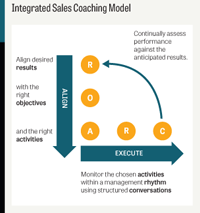TD Magazine Article
Avoid Sales Coaching Failure
The flaw in current coaching models is that they weren’t designed to apply to salesforces.
Mon Jul 08 2013

For decades, companies have trained and retrained their sales managers on how to coach their sales reps. Yet many organizations report that their sales managers do not coach well enough or often enough to maximize sales performance.
So why is it that so much money and energy have been invested in something that has yielded so much frustration from a training and development perspective? Is the sales training to blame? The sales managers? Both? Someone else?
The problem lies with the coaching models themselves. If there were any other explanation, an ideal sales coaching methodology would have been identified, and everyone would be using it with great success. It would be the de facto standard. But regrettably, this "ideal" sales coaching model does not exist. So what is it about traditional coaching models that hinders their successful deployment?
The limitation of traditional coaching models
Coaching models abound. There are probably hundreds in use right now in salesforces around the world. In your career, you've probably deployed several different versions of these models with various snazzy acronyms such as GROW (goals, reality, options, will) and GAINS (goal, assessment, ideas, next steps, support).
Whichever acronym you choose to use, coaching frameworks such as these all provide guidance down a somewhat similar path:
Assess current performance.
Identify gaps or areas for improvement.
Develop a plan to close those gaps or capture that improvement.
Act on that plan.
Assess progress.
Models such as these are called alignment coaching models because they help sellers align their day-to-day selling activities with their desired sales outcomes. They help managers and their direct reports to step back, judge the big picture, create a plan for improvement, execute that plan, and assess the resulting improvement.
The value of such a process is unassailable—these are valuable conversations to have. However, there is one characteristic that keeps these models from quickly and firmly taking hold in the salesforce.
The problem is that alignment coaching models aren't specifically tailored to the
specific needs of the salesforce. Any manager in any organizational function could use these models to coach his direct reports. But the salesforce is a unique organizational entity in many ways.
It is notoriously picky in the tools and frameworks it adopts, and they have to be easy to adopt. Something without easily recognizable terminology and obviously practical application is destined to struggle for life after training. On the other hand, a coaching model that uses familiar terms and is clearly applicable to sales reps' daily sales activities might just stand a chance.
A better alignment model
Our research, published in Cracking the Sales Management Code, reveals just such a coaching model. It is a straightforward alignment model that is derived from research into how leading salesforces are being measured and managed.
It contains only three components that must be aligned: business results, sales objectives, and sales activities. Interestingly, those components provide an intuitive path of cause and effect in the salesforce. Simply stated, certain sales activities lead to the accomplishment of certain sales objectives, and sales objectives lead to the attainment of ultimate business results.
For example, if a rep chooses to increase the volume of calls she makes on new prospects (an activity), then it's reasonable to believe that she would acquire more new customers (an objective). And if she captures more new customers, we would expect her to generate greater revenue (a result).
Therefore the "alignment" strategy in this results-objective-activity (ROA) model is to reverse-engineer the desired result. That is, begin with a desired business result, select a sales objective that will get you there, and identify the sales activities that will help you accomplish that objective.
For example, if the seller needs a certain amount of additional revenue to make her quota (a result), you need to decide how many new customers she needs to acquire to get there (an objective). And given that number of new customers, you need to determine how much more prospecting she needs to do to win those customers (an activity).
The ROA model is an improvement over traditional alignment models because the framework puts the coaching conversation is terms that resonate with a salesforce.
As a salesperson, would you feel more comfortable discussing your goals, reality, options, and will, or your business results, sales objectives, and sales activities? The more tactical and familiar you can make the alignment discussion, the more likely it is to become a reality—and stay that way.
Taking alignment into the field
This new sales-focused alignment model is an improvement over generic alignment models, but it also is insufficient to bring about sustainable coaching in a salesforce. That's because all alignment coaching models (including our own) are designed to facilitate periodic conversations. They enable better discussions between a manager and a rep in a regularly scheduled planning session or a performance initiative driven by poor sales results. However, they don't address the most critical determinant of sales performance and the result that senior executives most want: consistent execution in the field.
What is needed, then, is an execution coaching model to complement the alignment models—one that will bring the aligned sales activities to life and drive the attainment of the sales objectives and business results every day in the field. Without a model for sales execution, salesforces periodically will align and inconsistently execute.
What does execution coaching look like? Our study of management best practices discovered that there is no magic to integrating periodic alignment into daily execution. You just have to do it.
The best coaches are deliberate about setting aside time in their schedules to have conversations on execution. Sacred time. They realize that if they don't institute a formal management process or rhythm, they will quickly fall into a reactive world where all the important needs are pushed aside by all the urgent needs.
Further, these "execution coaching" sessions must be conducted in a structured way, so that the focus remains on helping the salespeople better execute the right activities. These are the sales activities that come out of the periodic alignment sessions discussed above. They are the important, high-impact activities that will benefit the most from structured coaching.
For example, if a seller agrees to acquire new customers (an objective) through increased prospecting calls (an activity), then the manager sets aside time to plan upcoming prospecting calls and qualify new opportunities. If a different seller agrees to grow her existing accounts through better account planning, then the manager sets aside time to review and discuss account plans with her. Nothing else needs to be discussed in these sessions. Discipline and structure are critical to successful coaching.
Through our research, a new model was uncovered for execution coaching, which we refer to as ARC:
Embed the key sales activities
in a formal management rhythm
with structured conversations.
The ARC model of execution coaching ensures that the As of the activities-objectives-results alignment conversations follow the reps into the field in a deliberate and consistent fashion. Execution, sales style.
When the ROA alignment model is combined with the ARC execution model, a comprehensive coaching framework is formed that ensures both alignment and execution take place in an integrated fashion (see figure).
The acronyms might not be all that jazzy, but they are specific to the salesforce and integrated into the day-to-day work of sellers, which makes them a noteworthy improvement over existing models.
A look to the future of sales coaching
So this is what we hope sales coaching will look like in the near future: Gone will be generic coaching models that are difficult for sellers to adopt. Also gone will be the hope that occasional alignment conversations somehow find their way into daily execution.
Instead, intermittent conversations will find their way into daily activities in a structured and predictable way, and sales managers will be armed with specific and effective coaching tools for elevating sales performance.
[

The flaw in current coaching models is that they weren't designed to apply to salesforces.
](http://files.astd.org/TD-Article-Images/2013/07/VazzanaSB-L.png)

